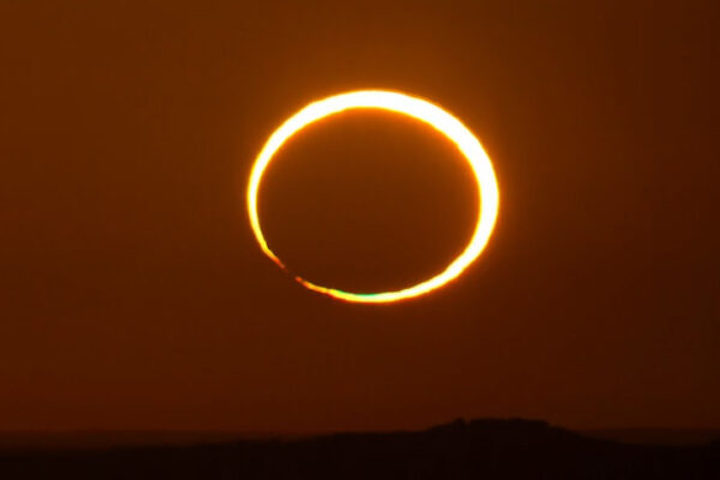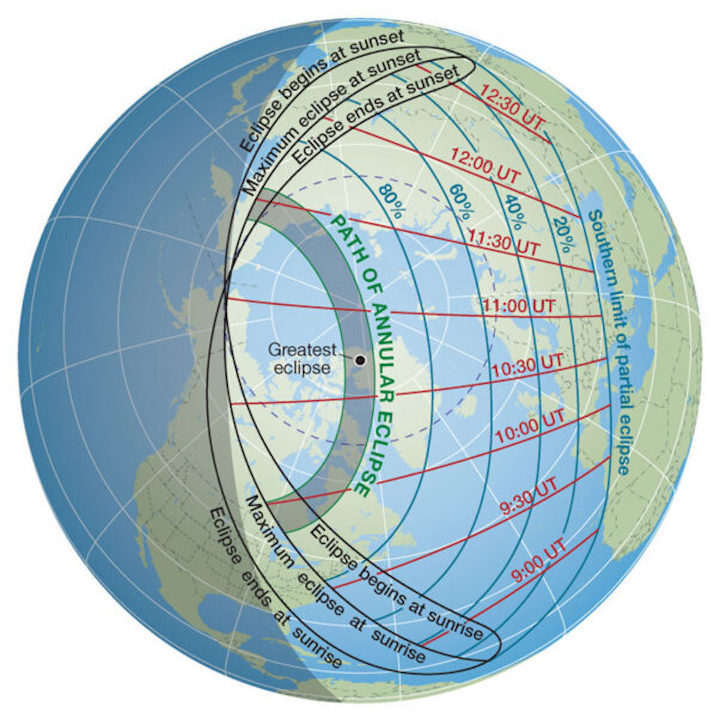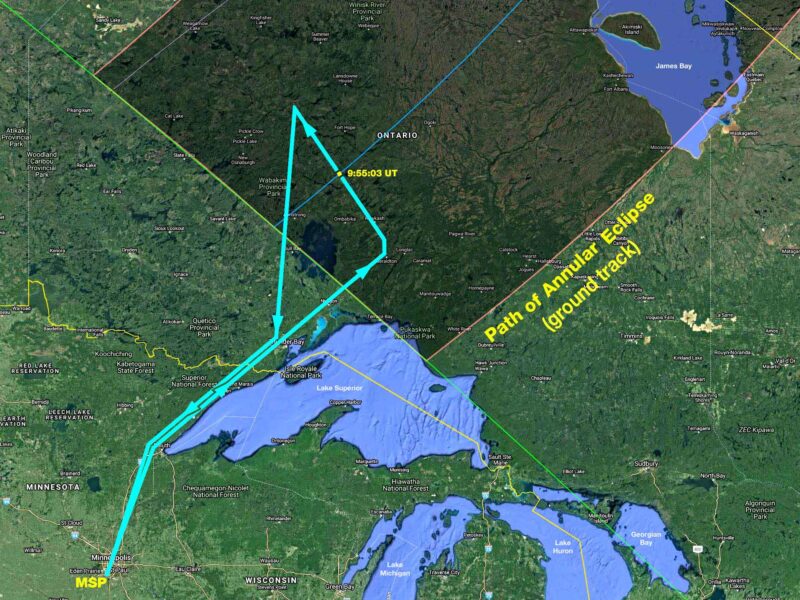3.04.2021
June 10th’s annular eclipse of the Sun has a path that crosses southern Canada and the North Pole but will be a challenge to see.

The Sun rose in the midst of an annular eclipse on May 10, 2013, as seen from Pilbara in Western Australia. This view was captured with an 800-mm lens just as the annular phase was ending (3rd contact). Note the slight elongation of the Sun’s disk and the lunar silhouette due to varying atmospheric refraction near the horizon. Click here to view the photographers’ video.
Geoff Sims & Colin Legg
Eclipse-chasers around the world have had a rough time lately. The COVID-19 pandemic thwarted many from seeing an annular solar eclipse across Africa and Asia in June 2020. Then, six months later, it upended plans for thousands who had planned trips to South America (including two Sky & Telescope tours) to see a total solar eclipse last December 14th.
The next chance to see one of these “central” solar eclipses happens on June 10th — just 10 weeks from now. But once again geography and circumstances will make witnessing it very challenging. As seen below, the path of annularity crosses southern Canada, the North Pole (!), Greenland, and eastern Siberia. These are huge stretches of sparsely inhabited territory, and just getting into annularity’s path will be extremely difficult.

The annular solar eclipse on June 10, 2021, will be observable from remote parts of Canada, Greenland, Siberia — and the North Pole!
Sky & Telescope; source: Fred Espenak
Eclipse veteran Stephen Bedingfield has looked into the prospects in northwestern Kalaallit Nunaat (the indigenous name for Greenland). “It is a stunning landscape and the people are so friendly — a place that remains in one’s heart,” Bedingfield says. But at present Greenland prohibits all nonessential travel, he cautions, “and frankly, having chatted to a knowledgeable Greenlander recently, I have no expectations that these restrictions will be lifted any time soon.”
So most eclipse-chasers have been eyeing the track’s path across southern Canada. “Visitors to Ontario’s Wabakimi Provincial Park will be able to see the rising Sun transform into a ring of light,” notes Joe Rao, who provides a detailed look at this eclipse in the June issue of Sky & Telescope. And at the Inuit hamlet of Pangnirtung on Baffin Island, Rao continues, “the location’s 1,500 inhabitants have an opportunity to see 2 minutes 38 seconds of annularity.”
That said, these viewing circumstances are hardly sure bets, because weather prospects in Canada aren’t great — and in fact the chance of clear skies anywhere along the eclipse track are only about 50%. To make matters worse, the Canadian government has prohibited entry into Canada for discretionary/optional travel by foreign nationals.
A WINDOW OF OPPORTUNITY
Eclipse-chasers tend to assess their prospects for success years in advance, and such was the case with June 10th’s annular eclipse. More than two years ago, I connected with Glenn Schneider, the unrivaled master of airborne eclipse viewing, to explore whether a chartered aircraft would allow a few dozen “umbraphiles” to view a especially dramatic annular eclipse just after sunrise over southern Canada.
The answer was “yes,” and that set in motion a planning effort that itself was fraught with challenges. First came negotiations with Delta Airlines to provide an A319-100 aircraft that would depart from the Minneapolis-St. Paul airport (MSP), fly into the path of annularity over southern Canada, and return to MSP. Then we worked with Canadian flight controllers to find a satisfactory route. Finally, we needed to submit a small mountain of paperwork to gain the U.S. Department of Transportation’s approval for a “public charter” (that is, a flight carrying paying passengers). At last check, I have received and sent 780 emails relating to this effort.

Map source: Xavier Jubier
Now this charter flight is a “go,” and it couldn’t be more timely. The 3-hour flight will head northeast from MSP and swing onto its eclipse-viewing leg just after sunrise, with the Moon’s silhouette already biting deeply into the Sun. Its passengers will witness 4m 26s of annularity, almost a minute longer than what would be seen on the ground, from an altitude of 38,000 feet.
| Our webpage about this “eclipse adventure” includes all the details about the flight’s route, logistical arrangements, and pricing. If you’re at all interested, please check it out right away because reservations will close in a few weeks. |
It’s hard to judge how many people will get to see this annular eclipse, but it’s not a lot — maybe 20,000 in total? — and that assumes that clear skies prevail all along the eclipse track.
Meanwhile, anyone in the Northeast U.S. and Canada’s Maritime Provinces will get to see a deep partial eclipse at or soon after sunrise on June 10th. (Finding an unobstructed view toward northeast will be a must!) For example, the Moon will cover 73% of the Sun’s disk from Sky & Telescope’s offices in Cambridge, Massachusetts. Joe Rao’s June article has many more details about that, and we’ll provide viewing times and circumstances online as well as June 10th approaches.
Quelle: Sky&Telescope

